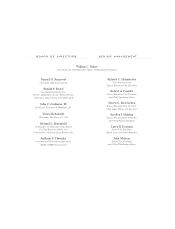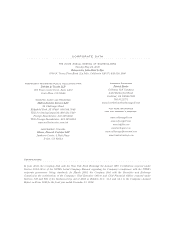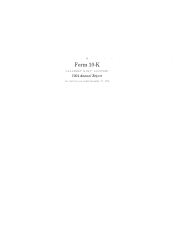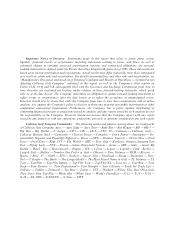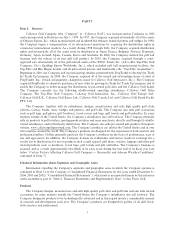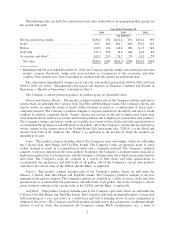Callaway 2004 Annual Report Download - page 14
Download and view the complete annual report
Please find page 14 of the 2004 Callaway annual report below. You can navigate through the pages in the report by either clicking on the pages listed below, or by using the keyword search tool below to find specific information within the annual report.
The majority of the Company's international sales are made through its wholly-owned subsidiaries
located in Europe, Japan, Canada, Korea and Australia. In addition to sales through its subsidiaries, the
Company also sells through distributors in over 65 foreign countries, including Singapore, Hong Kong,
Taiwan, China, the Philippines, India, South Africa and various countries in South America. Prices of golf
clubs and balls for sales by distributors outside of the United States generally reÖect an export pricing discount
to compensate international distributors for selling and distribution costs. A change in the Company's
relationship with signiÑcant distributors could negatively impact the volume of the Company's international
sales.
The Company's sales programs in foreign countries are speciÑcally designed based upon local laws and
competitive conditions. Some of the sales programs utilized include the custom club Ñtting experiences and
the Preferred Retailer Program or variations of those programs employed in the United States as described
above.
Conducting business outside of the United States subjects the Company to increased risks inherent in
international business. See below, ""Certain Factors AÅecting Callaway Golf Company Ì Foreign Currency
Risk'' and "" Ì International Risks'' contained in Item 7.
Sales of Pre-Owned Golf Clubs
The Company sells certiÑed, pre-owned Callaway Golf products through its website,
www.callawaygolfpreowned.com. The Company generally acquires the pre-owned products through the
Company's Trade In! Trade Up! program. The website for this program is www.tradeintradeup.com. The
Trade In! Trade Up! program gives golfers the opportunity to trade in their used Callaway Golf and select
competitor golf clubs at authorized Callaway Golf retailers or through the Callaway Golf Pre-Owned website
for credit toward the purchase of new or pre-owned Callaway Golf equipment.
Advertising and Promotion
Within the United States, the Company has focused its advertising eÅorts mainly on a combination of
television commercials, primarily during golf telecasts, and printed advertisements in national magazines, such
as Golf Magazine, Golf World and Golfweek. Advertising of the Company's products outside of the United
States is generally handled by the Company's subsidiaries in coordination with U.S. direction.
In addition, the Company establishes relationships with professional golfers and celebrities from other
industries in order to promote the Company's products. The Company has entered into endorsement
arrangements with members of the various professional golf tours to promote the Company's golf club and ball
products. For certain risks associated with such endorsements, see below, ""Certain Factors AÅecting Callaway
Golf Company Ì Golf Professional Endorsements'' contained in Item 7.
Competition
The golf club markets in which the Company competes are highly competitive, and are served by a
number of well-established and well-Ñnanced companies with recognized brand names, as well as new
companies with popular products. With respect to metal woods and irons, the Company's major competitors
are TaylorMade, Titleist, Cobra, Cleveland, Ping and Mizuno. For putters, the Company's major competitors
are Ping and Titleist. In addition, the Company also competes with Dunlop, Bridgestone and PRGR among
others in Japan and throughout Asia. The Company believes that it is the leader, or one of the leaders, in every
golf club market in which it competes.
The golf ball business is also highly competitive. There are a number of well-established and well-
Ñnanced competitors, including Acushnet (Titleist and Pinnacle), Sumitomo Rubber Industries (Srixon),
Bridgestone (Precept), Nike, TaylorMade (MaxFli) and others. These competitors have established market
share in the golf ball business, with Acushnet having a market share of approximately 50% of the golf ball
business in the United States. The Company's golf ball products have been well received by both professional
5


